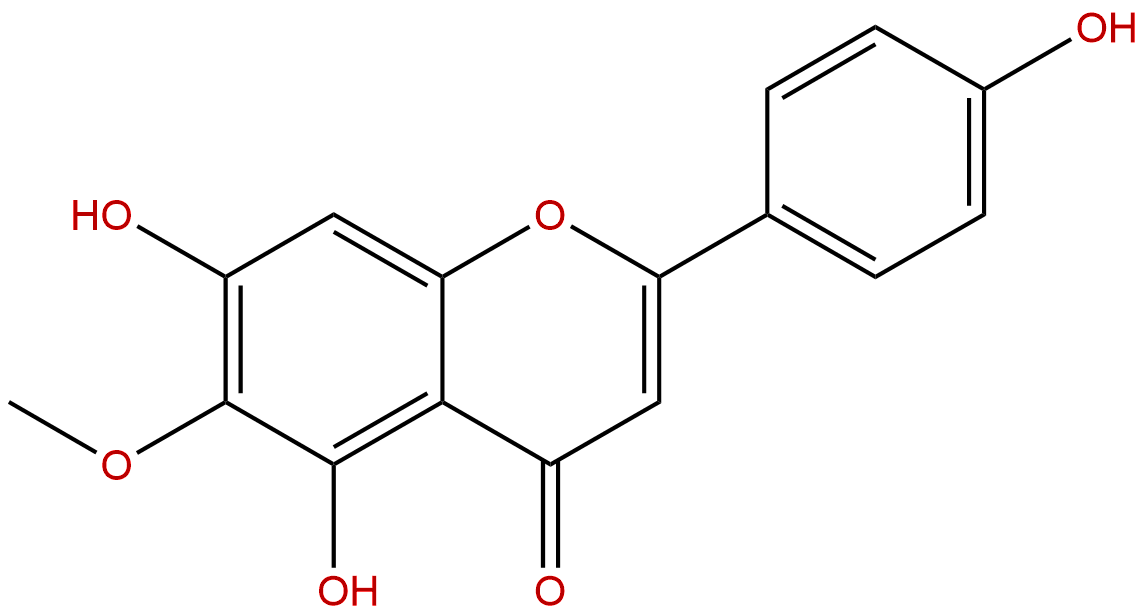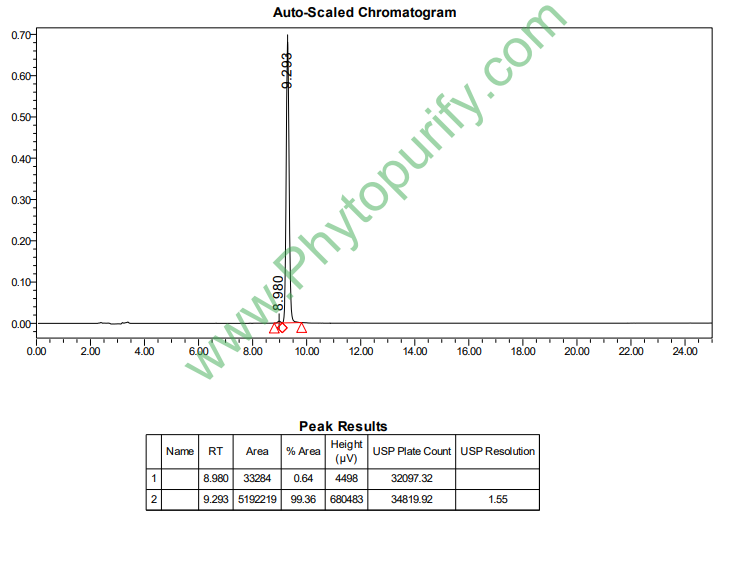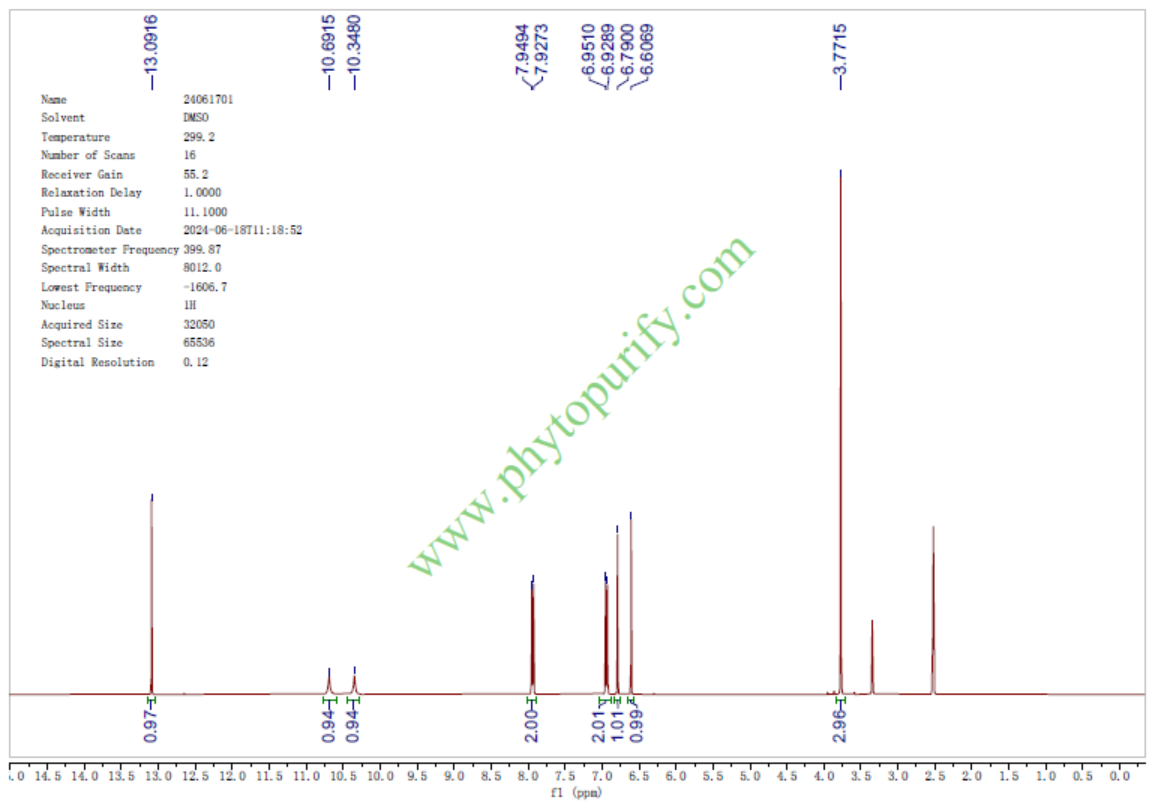
HispidulinCAS No.:1447-88-7
|
||||||||||
 |
|
|
||||||||

| Catalogue No.: | BP0730 |
| Formula: | C16H12O6 |
| Mol Weight: | 300.266 |
Product name: Hispidulin
Synonym name: Hispidulin; Methoxyapigenin
Catalogue No.: BP0730
Cas No.: 1447-88-7
Formula: C16H12O6
Mol Weight: 300.266
Botanical Source: Salvia plebeia R. Br.
Physical Description:
Type of Compound: Flavonoids
Purity: 95%~99%
Analysis Method: HPLC-DAD or/and HPLC-ELSD
Identification Method: Mass, NMR
Packing: Brown vial or HDPE plastic bottle
Storage: Store in a well closed container, protected from air and light. Put into refrigerate or freeze for long term storage.
Whenever possible, you should prepare and use solutions on the same day. However, if you need to make up stock solutions in advance, we recommend that you store the solution as aliquots in tightly sealed vials at -20℃. Generally, these will be useable for up to two weeks.
The product could be supplied from milligrams to grams
Inquire for bulk scale.
Description:
Hispidulin has anti-oxidative, anti-inflammatory, anti-cancer, antiepileptic, neuroprotective, anti-osteoporotic and bone resorption attenuating effects, it targets the VEGF receptor 2-mediated PI3K/Akt/mTOR signaling pathway in endothelial cells, leading to the suppression of pancreatic tumor growth and angiogenesis. Hispidulin can ameliorate high glucose-mediated endothelial dysfunction via inhibiting PKCβII-associated NLRP3 inflammasome activation and NF-κB signaling, it has potential application in the prevention and treatment of diabetic vascular complications. Hispidulin can inhibit platelet aggregation by elevating cAMP levels by a mechanism different from that of theophylline or PGE1.
References:
J. Funct. Foods, 2016, 27:392-405.
Ameliorative effects of hispidulin on high glucose-mediated endothelial dysfunction via inhibition of PKCβII-associated NLRP3 inflammasome activation and NF-κB signaling in endothelial cells
Endothelial dysfunction is closely relevant to atherosclerosis complications in diabetic patients. Hispidulin, a flavone derived from the herb Salvia plebeia R. Br., has numerous biological properties including anti-inflammatory and antioxidative effects, but the underlying mechanism of its anti-inflammatory action remains unclear. This study was designed to investigate the effects of Hispidulinon endothelial homeostasis and its mechanism.
METHODS AND RESULTS:
Hispidulin effectively inhibited high glucose-induced oxidative stress by attenuating PKCβII phosphorylation and downstream reactive oxygen species (ROS) production, furthermore reversing the loss of mitochondria membrane potential. Moreover, Hispidulin significantly suppressed the expression of NLRP3 inflammasome and IKKβ/NF-κB, and restored high glucose-impaired vasodilation in rat aorta.
CONCLUSIONS:
This study demonstrated that Hispidulin ameliorated high glucose-mediated endothelial dysfunction via inhibiting PKCβII-associated NLRP3 inflammasome activation and NF-κB signaling. Besides, these findings indicate the beneficial effects of Hispidulin on the improvement of endothelial dysfunction and explain its potential application in the prevention and treatment of diabetic vascular complications.
Eur J Pharmacol. 1988 Feb 16;147(1):1-6.
Hispidulin, a natural flavone, inhibits human platelet aggregation by increasing cAMP levels.
Hispidulin, a natural flavone, and theophylline inhibited platelet aggregation triggered by adenosine-5'-monophosphate, arachidonic acid, paf-acether and collagen.
METHODS AND RESULTS:
Hispidulin was 100-fold more potent than theophylline. A threshold concentration of PGE1 did not modify the anti-aggregatory effect of Hispidulin but potentiated the effect of theophylline. A threshold concentration of Hispidulin had no effect on the inhibitory action of theophylline. Hispidulin (100 microM) and theophylline (10 mM) increased the control cAMP level in platelets 4-fold. A threshold concentration of PGE1 had a small effect on Hispidulin-induced cAMP levels but increased the theophylline-induced cAMP levels 3-fold. Theophylline (10 mM)-induced cAMP levels were not modified by Hispidulin. We demonstrate a correlation between the inhibition of platelet aggregation and the increase in cAMP levels induced by Hispidulin.
CONCLUSIONS:
These data suggest that Hispidulin could inhibit platelet aggregation by elevating cAMP levels by a mechanism different from that of theophylline or PGE1.
Eur J Pharmacol. 2015 May 15;755:6-15.
Protective effect of hispidulin on kainic acid-induced seizures and neurotoxicity in rats.
Hispidulin is a flavonoid compound which is an active ingredient in a number of traditional Chinese medicinal herbs, and it has been reported to inhibit glutamate release. The purpose of this study was to investigate whether Hispidulin protects against seizures induced by kainic acid, a glutamate analog with excitotoxic properties.
METHODS AND RESULTS:
The results indicated that intraperitoneally administering Hispidulin (10 or 50mg/kg) to rats 30min before intraperitoneally injecting kainic acid (15mg/kg) increased seizure latency and decreased seizure score. In addition, Hispidulin substantially attenuated kainic acid-induced hippocampal neuronal cell death, and this protective effect was accompanied by the suppression of microglial activation and the production of proinflammatory cytokines such as interleukin-1β, interleukin-6, and tumor necrosis factor-α in the hippocampus. Moreover, Hispidulin reduced kainic acid-induced c-Fos expression and the activation of mitogen-activated protein kinases in the hippocampus.
CONCLUSIONS:
These data suggest that Hispidulin has considerable antiepileptic, neuroprotective, and antiinflammatory effects on kainic acid-induced seizures in rats.
Cell Biochem Biophys. 2014 Jun;69(2):311-7.
Hispidulin exerts anti-osteoporotic activity in ovariectomized mice via activating AMPK signaling pathway.
To investigate the effect of Hispidulin on ovariectomy (OVX)-induced bone loss in mice.
METHODS AND RESULTS:
Female mice subjected to OVX were treated with Hispidulin for 8 weeks. The total body bone mineral density was measured at the beginning and after the OVX at a time interval of 4 weeks. Micro-computed tomography of the tibia, bone histomorphometric analysis of the femur, and biomechanical analysis of tibia, vertebra, and femoral head were performed to fully evaluate the anti-osteoporotic effect of Hispidulin. Western blot analysis was performed to determine the level of activated AMPK. Hispidulin treatment effectively prevented OVX-induced body weight loss and attenuated OVX-induced bone loss. Hispidulin treatment also decreased trabecular spacing in OVX mice. The suppressing effect of Hispidulin on osteoclast surface and number was also found via histomorphometric analysis. Western blot analysis revealed that Hispidulin significantly elevated the activated AMPK levels.
CONCLUSIONS:
Our findings suggest that Hispidulin exerts anti-osteoporotic and bone resorption attenuating effects via activating the AMPK signaling pathway.
HPLC of Hispidulin

HNMR of Hispidulin
